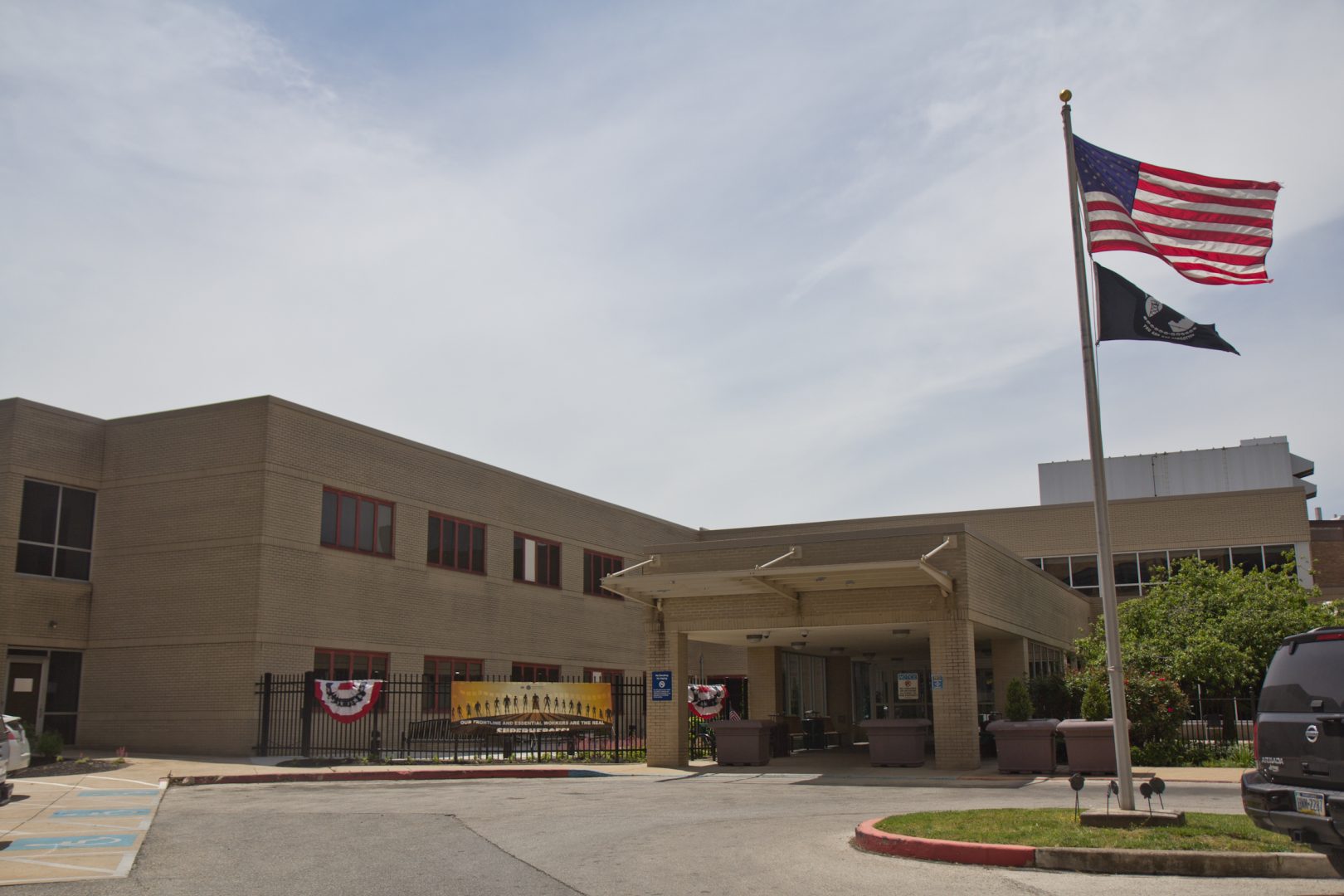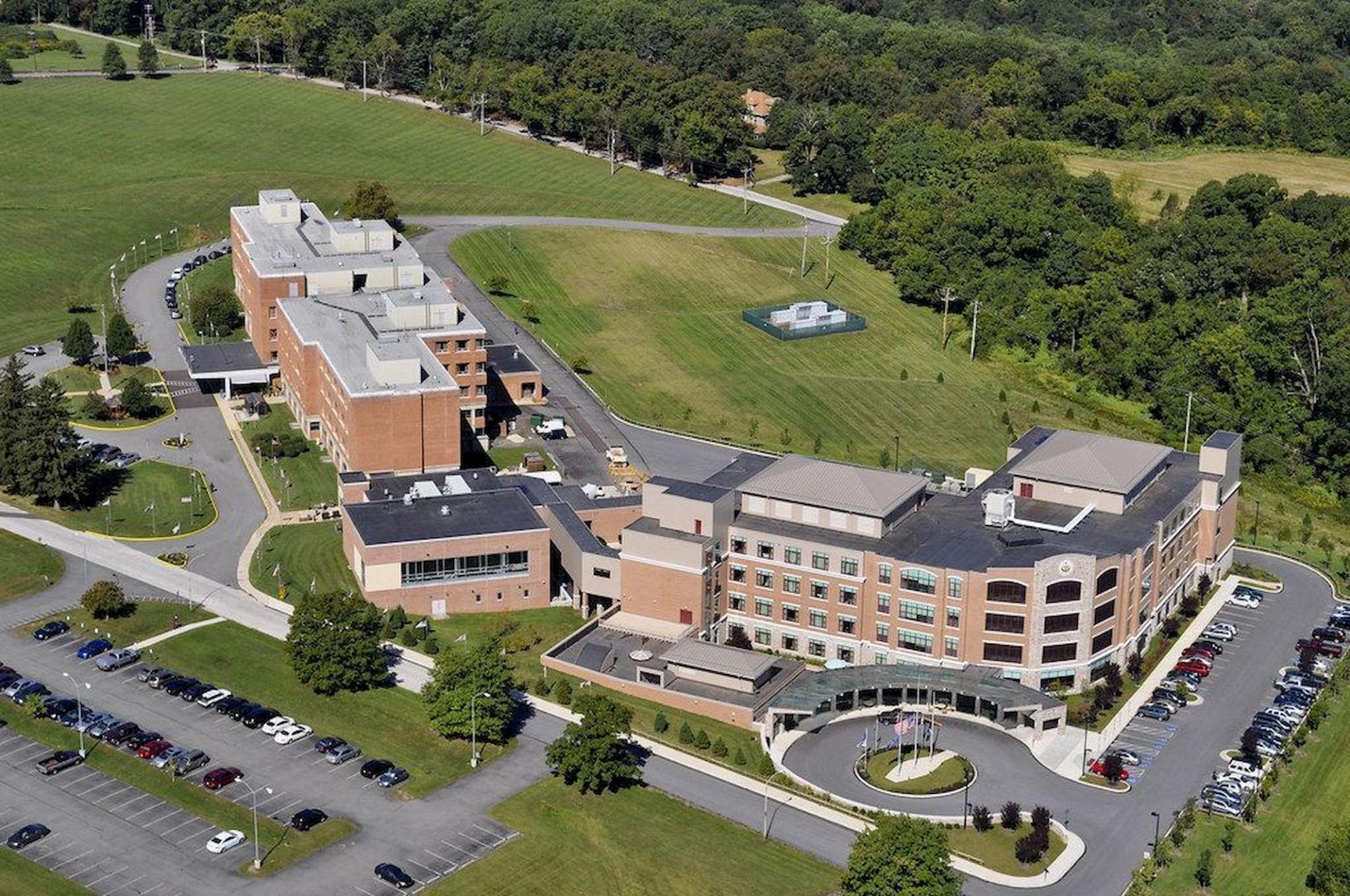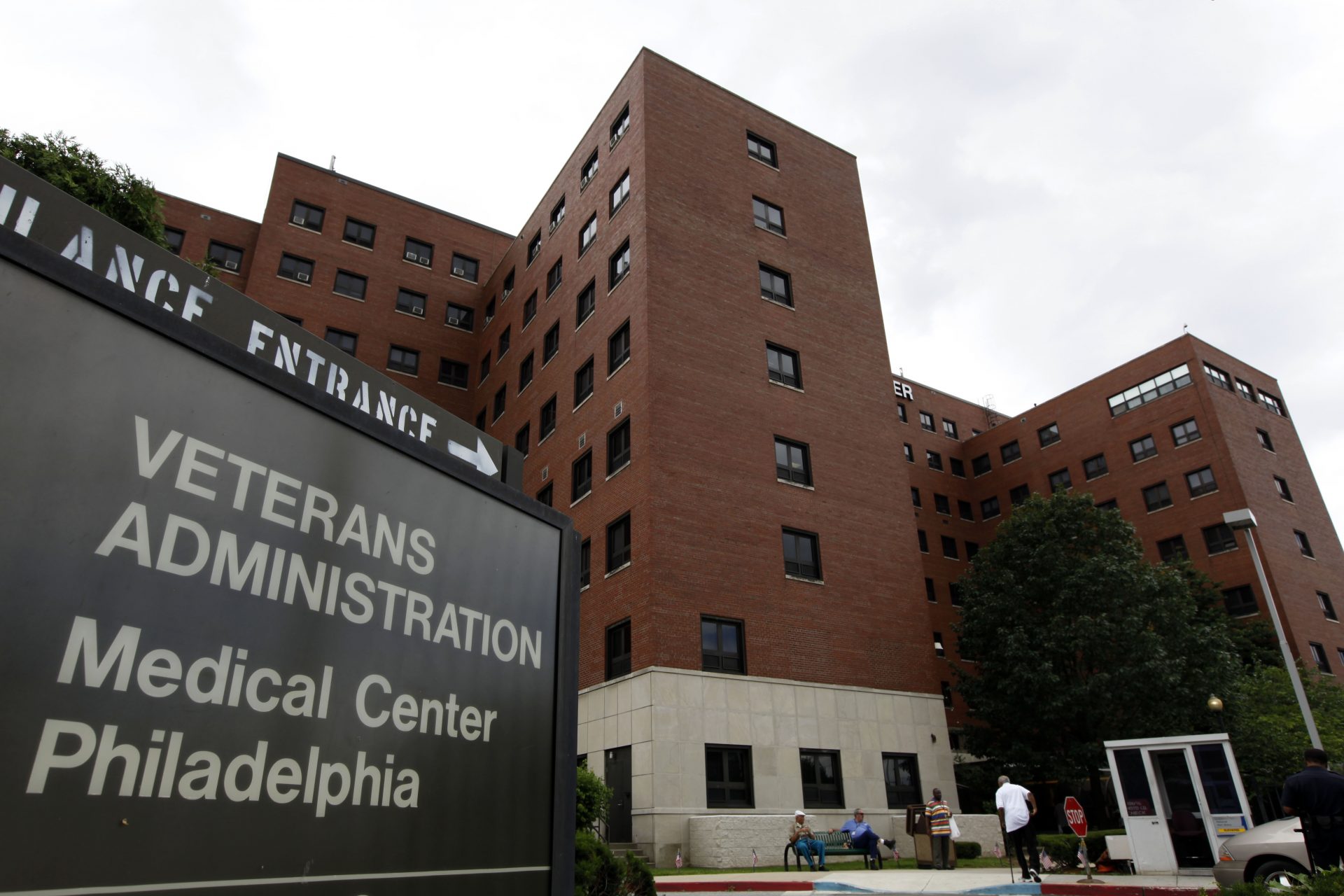
The U.S. Dept. of Veterans Affairs Community Living Center in the University City neighborhood in Philadelphia.
Kimberly Paynter / WHYY

The U.S. Dept. of Veterans Affairs Community Living Center in the University City neighborhood in Philadelphia.
Kimberly Paynter / WHYY

Kimberly Paynter / WHYY
The U.S. Dept. of Veterans Affairs Community Living Center in the University City neighborhood in Philadelphia.
What you should know
» Coronavirus facts & FAQ
» Day-by-day look at coronavirus disease cases in Pa.
» Red, yellow, green: What to expect in each of Pa.’s tiers for reopening
(Philadelphia) — Memorial Day honors the men and women who died while serving in the U.S. military. It’s a time when many visit the graves of loved ones who passed away and place American flags by their gravesites.
With the coronavirus on everyone’s mind, veterans have been in the news lately, as a number of long-term care facilities serving them have experienced high levels of fatalities from COVID-19.
The Cpl. Michael J. Crescenz Veterans Administration Medical Center in West Philadelphia is a federal facility that provides care to about 57,000 veterans in the tri-state area. Within the hospital is a long-term care home that typically houses about 100 veterans. So far, 28 residents of the home, known as the Community Living Center, have tested positive, and three have died of COVID-19. Still, that’s a better track record than many nursing homes battling the virus.
Officials say testing has been crucial in limiting the outbreak at the Community Living Center. The VA medical center already served as a regional molecular testing hub for infectious diseases like HIV, chlamydia and gonorrhea. So it was able to transition the same equipment to test for COVID-19.
“We had a head start, if you will, in the sense that we had the basic testing equipment in place that we used for other purposes,” said John Kelly, chief of staff at the VA Medical Center and an infectious disease specialist. “If you didn’t have those very sophisticated laboratory instruments in your hospital, you couldn’t run those test kits. But they were some of the earliest kits out of the gate, so that served us well to have that testing equipment in-house already.”
The VA began using two testing platforms to test for the viral particles known as antigens, including one from the diagnostic testing company Abbott.
“In-house implementation of Abbott testing requires one to have an efficient microbiology section within the lab,” said Darshana Jhala, chief of pathology at the VA Medical Center. “And laboratory technologists trained as molecular technologists, you have to have an oversight by an M.D., or M.D. PhD. All these factors together, I think, lead to a successful implementation of in-house testing with a good turn-around time.”
Jhala said the VA lab is able to perform 8,000 tests a month using the Abbott testing platform, with a turnaround time for results of between four and 24 hours.
“Once we had identified a case among our residents,” said Kelly, “we were able to implement wide-scale testing and then retesting and then retesting to help us monitor the progress and the successes of our interventions in reducing the spread within our nursing facility.”
Currently, the VA is not testing for antibodies, which could reveal whether a person had COVID-19 and recovered. The accuracy of antibody tests is in dispute.
But even some testing for antigens can reveal false negatives, so the VA also relies on temperature checks. Some who have tested positive and recovered from the disease have continued to test positive three to four weeks later, said Kelly. But he said that doesn’t necessarily mean the person remains contagious.
“The question is how long can you shed the virus, and it’s not completely answered yet,” said Kelly. “But there is no evidence that there is any virus that is reproductively capable beyond nine to 10 days. So when we’re detecting virus at up to three weeks, it’s not clear that that’s infectious. I don’t want to say that it’s not, but there’s no evidence yet that that’s infectious. It may just be viral genetic material or antigens that we’re detecting in our assays.”

PA Dept. of Military and Veterans Affairs
Sen. Katie Muth said guidance without enforcement is useless, pointing to the Southeastern Veterans’ Center where officials concealed the extent of an outbreak even as the death toll nearly tripled over a five-day stretch in April.
In addition to the in-house testing, it helped that the nursing home is part of a larger medical facility. About 70% of all COVID-19 deaths in Pennsylvania have occurred in care facilities such as the VA’s Community Living Center. Residents often share rooms, dining halls, and recreation areas. Some residents may suffer from dementia and not understand the need for social distancing.
In mid-March, the VA conducted baseline tests for COVID-19 among all the residents and staff at the nursing home. Some positive results surprised them — there were residents and workers who had no idea they had the virus.
What are now considered best practices for care homes were implemented: Residents who test positive are isolated on a separate ward of the nursing home, where they are cared for by a staff who do not have contact with any of the other residents, or other staff members. Visitors were banned. And, unlike at some care centers across the region, no new residents are being accepted at this facility.
Jhala said finding out who had the virus, whether they displayed symptoms or not, was key.
“So I think we are still learning about this disease,” said Jhala, “and I think what we have learned so far from this is that widespread testing does have a role. For example, in the Community Living Center, if we would not have done widespread testing, we would not know who the asymptomatic carriers are. And that was in an outbreak setting.”
On the day the first positive patient was detected, Jhala said, the lab was able to test 170 samples.
“And that really helped us prevent any further spread or increasing the severity,” Jhala said.
Residents at the Community Living Center can return to their regular rooms only once they test negative for the coronavirus.
But another key factor in preventing spread of the virus was testing and monitoring workers — everyone from nurses to cleaners to security staff.
Workers at the VA said they now have decent personal protective equipment, or PPE, although that wasn’t the case at the beginning of the outbreak in March.
“In late March, we weren’t wearing face marks at all in the medical center,” said Yul Owens, who works as a pharmacy technician in the Community Living Center. “Now, things like that have completely turned around. We’re all mindful of wearing N95 masks and protective equipment when doing direct patient care with COVID-19 patients. The housekeeping staff has been diligent in sanitizing the building. So things have stepped up a notch since this first started happening in March.”
Owens is also the executive vice president of American Federation of Government Employees Local 1793, the union that represents about 1,700 workers at the facility.

Matt Rourke / AP Photo
FILE PHOTO: People stand outside the Veterans Administration Medical Center in Philadelphia, Monday, June 22, 2009.
Currently, workers have to show symptoms or be exposed to someone who is positive to get a test. So far, about 25 staff out of 320 workers at the nursing home have tested positive. None have died.
If employees test positive, they stay home for at least 10 days. The VA also conducts contact tracing, to find out who in the community may have been exposed to the virus.
Owens said the union is pushing for hazard pay for workers, and to make sure workers who have to quarantine are not forced to use their sick time to do so.
Kelly said questions remain on the best approach to testing staff.
“There are people who say, ‘Well, we should test every staff member.’ Well, you could do that, but how often? Because if somebody’s negative today on Tuesday, it doesn’t mean they won’t be asymptomatically shedding [the virus] and test positive on Thursday. So there are a lot of unanswered questions about that strategy, and I think they’ll get answered over time as we get more experience with the virus.”
Attention to care-home worker health and testing is something Zach Shamberg has been pushing. Shamberg is president of the Pennsylvania Health Care Association, which represents long-term care facilities, patients, and workers.
“Absent access to a vaccine, we know that widespread testing and the use of PPE can stop the spread of the virus, so I think that can never be more important as it relates to testing of staff,” said Shamberg.
He said he was glad to hear Gov. Tom Wolf recommend such testing at nursing homes. But testing is expensive, and unlike the VA facility in Philadelphia, most nursing homes do not have in-house testing capability.
Shamberg worries what will happen if a new surge of infections appear as predicted in the fall.
“This is going to be long-lasting in long-term care,” said Shamberg. “It will be many, many months, if not years, before this is over. And if there’s a second wave in the fall, this will very much affect long-term care over the course of the next year. So there’s no light at the end of the tunnel.”
Shamberg said it would cost more than $22 million to test each worker and each resident just once at care home facilities in Pennsylvania.
WHYY is the leading public media station serving the Philadelphia region, including Delaware, South Jersey and Pennsylvania. This story originally appeared on WHYY.org.

Get insights into WITF’s newsroom and an invitation to join in the pursuit of trustworthy journalism.
The days of journalism’s one-way street of simply producing stories for the public have long been over. Now, it’s time to find better ways to interact with you and ensure we meet your high standards of what a credible media organization should be.